
Home
Preamble
Index
Areas
Hills
Lakes
Dales
Map
References
Me
Drakkar
Saunterings: Walking in North-West England
Saunterings is a set of reflections based upon walks around the counties of Cumbria, Lancashire and
North Yorkshire in North-West England
(as defined in the Preamble).
Here is a list of all Saunterings so far.
If you'd like to give a comment, correction or update (all are very welcome) or to
be notified by email when a new item is posted - please send an email to johnselfdrakkar@gmail.com.
197. Around the Windmills of My Mind, Metaphorically Writing
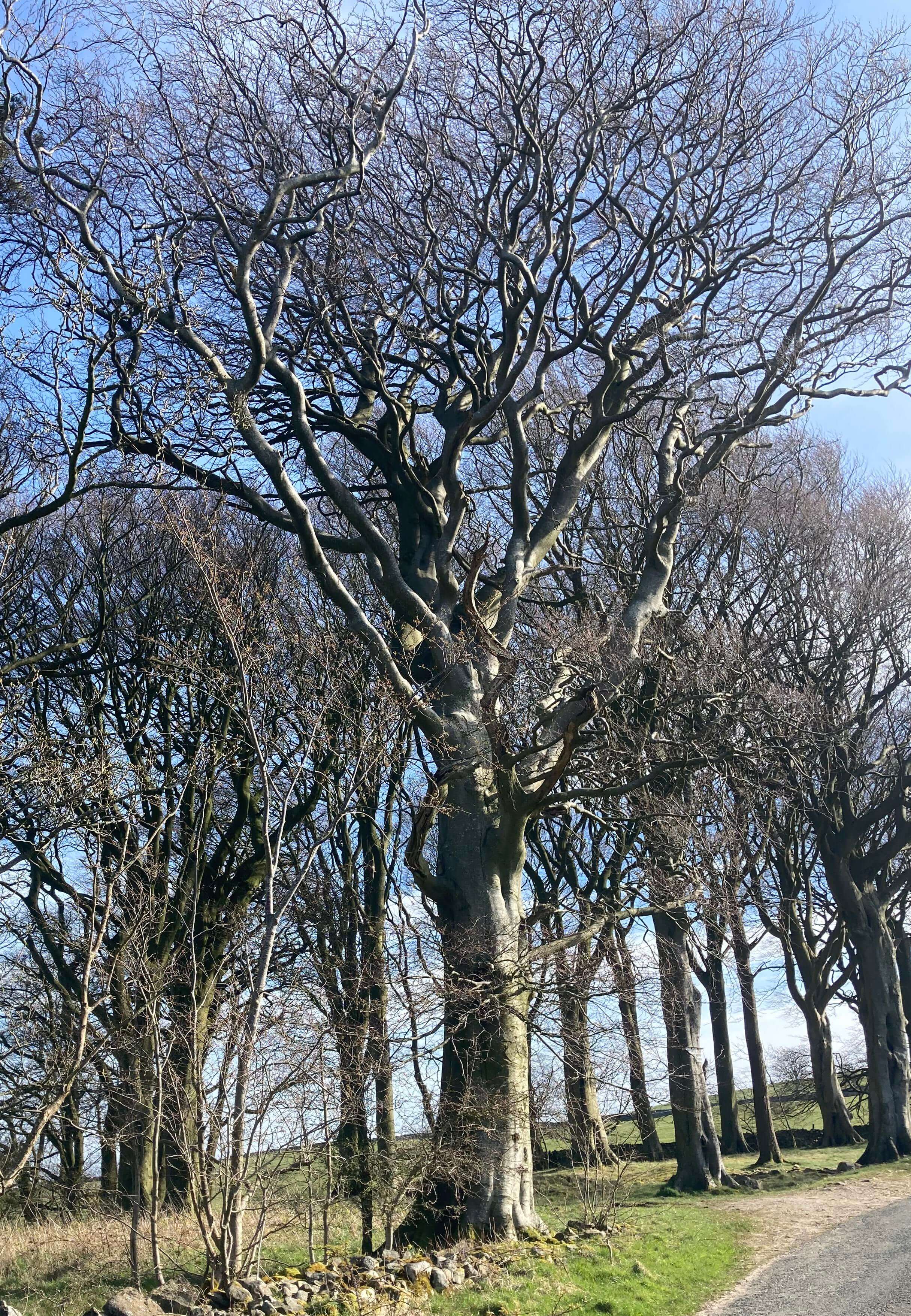 The mention of Mr Tambourine Man’s jingle jangle morning in Sauntering 195 reminded me of
The mention of Mr Tambourine Man’s jingle jangle morning in Sauntering 195 reminded me of
Keys that jingle in your pocket, words that jangle in your head
from the
The Windmills of Your Mind, which was
written for the film
The Thomas Crown Affair (1968) and which begins
Round like a circle in a spiral, like a wheel within a wheel
Never ending or beginning on an ever-spinning reel …
Like the circles that you find in the windmills of your mind
which reminded me that I hadn’t walked up to the Caton Moor windmills for months. In recent
weeks I had headed in that direction, trying to walk a little further each time, but
I never got even halfway. Today I felt bolder.
I walked past Moorside Farm up Quarry Road into an unexpectedly stiff breeze. I envied
a runner and two cyclists who sailed downhill past me but as I battled on up I reflected
that they too must have battled up earlier. The views opened out but it was disappointingly
murky. I could see no detail on the grey hills up the valley. The Lake District hills
came into view – but there was no view of them. I could just about make out the shape of
Black Combe but that was all.
 At the picnic spot by the windmills I paused for a snack. Only five of the eight
windmills were turning. It always seems jarring when the windmills are not in unison. There
was clearly enough wind to turn them all but it seemed that three of them were facing the
wrong direction. I’d have thought that by now engineers would have perfected a design that
ensured the windmills aligned themselves correctly.
At the picnic spot by the windmills I paused for a snack. Only five of the eight
windmills were turning. It always seems jarring when the windmills are not in unison. There
was clearly enough wind to turn them all but it seemed that three of them were facing the
wrong direction. I’d have thought that by now engineers would have perfected a design that
ensured the windmills aligned themselves correctly.
I had set out with a see-how-it-goes non-plan. I had already walked far enough that by
the time I’d walked home this would be the furthest I’ve walked for nearly three months. So with
the wind against me and with memories of last week’s struggle with the mud I decided to just
walk around the windmills and not walk on up to the trig point across the porridge of Caton Moor.
I am always hesitant when using metaphors. They require a reader to transfer
features (such as wetness, lumpiness, stickiness) from a familiar concept (such as porridge)
to a less familiar one (such as Caton Moor), without transferring irrelevant features (such
as hotness and nutritiousness). That’s risky: I wouldn’t want you to think that after a
taste of Caton Moor you’d be strong enough to toss cabers. Nonetheless, the most
highly-rated nature writers (at least, by fellow nature writers) are often those who make
liberal use of metaphors. They add a lyrical, poetic tone to the prose.
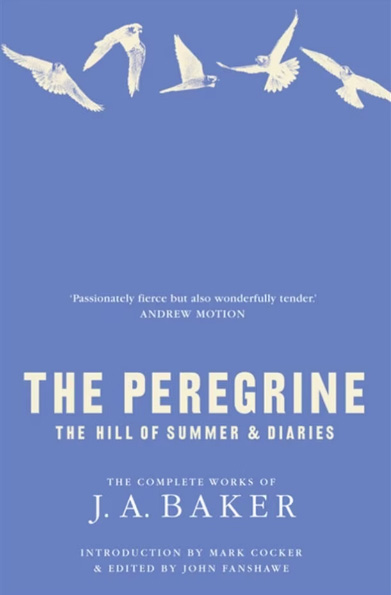 The writer
J.A. Baker, who wrote The Peregrine (1967), which is often said to
be the best nature book of the 20th century, kept a count of how many metaphors and similes
he had on each page. He obviously considered them important for his style. Perhaps he
had a target in mind to achieve the effect he intended or a threshold he didn’t want to
cross to avoid appearing too flowery. It took him ten years to write the book and I am not
surprised, having to think up all those metaphors.
The writer
J.A. Baker, who wrote The Peregrine (1967), which is often said to
be the best nature book of the 20th century, kept a count of how many metaphors and similes
he had on each page. He obviously considered them important for his style. Perhaps he
had a target in mind to achieve the effect he intended or a threshold he didn’t want to
cross to avoid appearing too flowery. It took him ten years to write the book and I am not
surprised, having to think up all those metaphors.
It takes nearly as long to read the book. Here’s a couple of short sentences at random:
Knot were resting. They had a slant-eyed mongol look, like sleeping huskies.
Perhaps our eyes are supposed to glide over such text, absorbing its sense, but, really,
who can read it without wrestling with a number of questions: Do huskies really have
slanted eyes? Perhaps only when sleeping? Huskies sleep lying on the
ground – do knot? Or are the knot just resting, not sleeping? Do knot
rest with their eyes closed? By ‘mongol’ does he mean ‘Mongol’? My dictionary
(admittedly rather old but more recent than Baker’s book) says that lower-case ‘mongol’
means ‘a person affected by Mongolism … a disease now more usually called Down’s syndrome’.
Isn’t ‘mongol’ offensive, if not racist? By which time, I’ve forgotten whatever
I was reading about.
Those two sentences concern knot. There are many similar descriptions of other species
of bird, including probably hundreds of the book’s focus, the peregrine. Here’s one:
Her long, powerful head, like a hooked pike glaring from reeds, flexed slowly round as
she scanned the fields below. The two deep-brown moustachial bars shone glossily in the
sun, hanging down each side of the bill like strips of polished leather. The large
dark eyes, and the bare white patches of skin in front of them, glinted black and white
like wet flint. The low sun glowed the hawk’s colours into rich relief: copper and
rust of dead beech leaves, shining damp-earth brown.
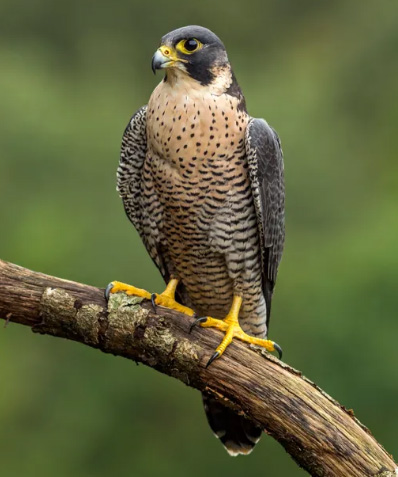 It is too much for me. It’s like a waiter bringing me sweet course after sweet course
after sweet course. Thoughts of pike, moustaches, leather, flint and beech jangle in my
head. I prefer writers to tell me directly what they mean, which (I know) is easier
said than written. I don’t want to spend an evening trying to make sense of a paragraph
of fanciful allusions. But perhaps I should. We are encouraged to think that reading
fast is good. Perhaps it is better to read slowly and deeply.
It is too much for me. It’s like a waiter bringing me sweet course after sweet course
after sweet course. Thoughts of pike, moustaches, leather, flint and beech jangle in my
head. I prefer writers to tell me directly what they mean, which (I know) is easier
said than written. I don’t want to spend an evening trying to make sense of a paragraph
of fanciful allusions. But perhaps I should. We are encouraged to think that reading
fast is good. Perhaps it is better to read slowly and deeply.
I rose from my picnic bench and walked up to the gate to the windmills. What I think
of as the ‘moorland quartet’ (skylark, curlew, lapwing, oystercatcher) were all in good voice.
It was the first time I’ve heard them in their element this year. I then had a decision to
make about the way to walk back down – whether down the road or across the moor and pastures.
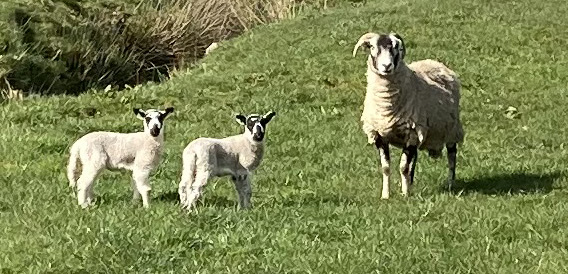 Decades ago I was used to running and walking the five-mile circuit across fields from
home. There were no windmills or open access areas at first, so I suppose I was trespassing.
But nobody minded. I rarely saw anybody and if I did meet a farmer there’d always be a wave
and perhaps a brief chat. Nobody ever indicated that I shouldn’t be there. On the contrary,
I felt that farmers were pleased that somebody appreciated their fields.
Decades ago I was used to running and walking the five-mile circuit across fields from
home. There were no windmills or open access areas at first, so I suppose I was trespassing.
But nobody minded. I rarely saw anybody and if I did meet a farmer there’d always be a wave
and perhaps a brief chat. Nobody ever indicated that I shouldn’t be there. On the contrary,
I felt that farmers were pleased that somebody appreciated their fields.
Then my circuit became partly open access and then the part that wasn’t became a
permissive path. Great!, it seemed. I could now run and walk the circuit with a clear
conscience. But then, after a few years, the permissive path lapsed. The council couldn’t
afford to maintain it (it was supposed to be a ‘tramper trail’ too) and anyway farmers found
that – inevitably it seems – some of the walkers encouraged here by the new permissive path
let their dogs harass sheep and left gates open. So there’s now a large red ‘private’ sign
at the lower end of the once-permissive path. Where I had always wandered freely, with
or without permission, was now firmly out of bounds.
I wondered if there was a ‘private’ sign at the upper end of the once-permissive path.
I walked over the moor to find out. There was. Now, I’m not sure that I should admit
this here, but I ignored it. I really wanted to see again the fields that I was once so
familiar with. I figured that, in the unlikely event that I should see a farmer, then
he or she would probably be as friendly as they used to be. They might even recognise me.
Certainly, I hoped that if I explained my long-term emotional attachment to these fields
then they would be accommodating. In the event, I did see a farmer, in the distance
tending his sheep. If he saw me – and I expect he did, as I didn’t try to hide – he ignored
me. I enjoyed my reunion with these fields – but
(unless perhaps your feet have also trodden them for over forty years) you should not trespass here.
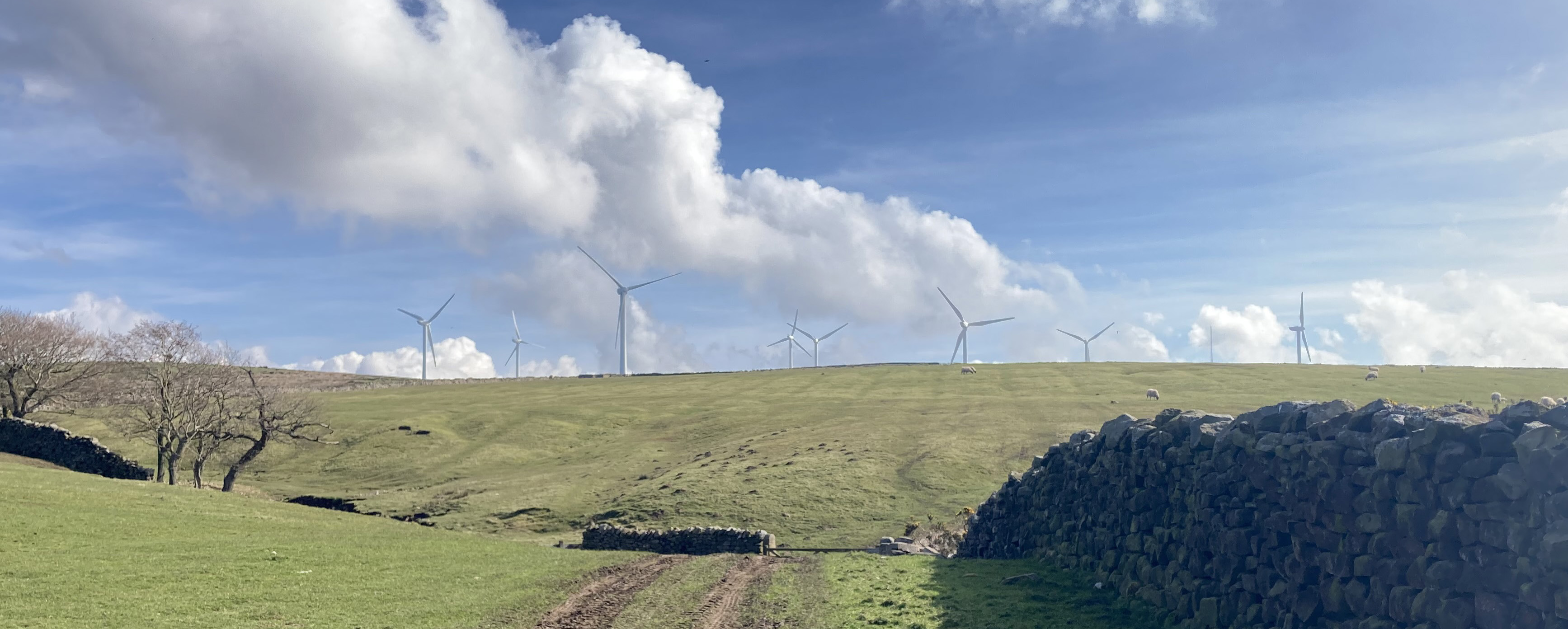
Date: March 31st 2024
Start: SD543644, Brookhouse (Map: OL41)
Route: SE, E on Quarry Road – picnic site – S along the windmill track,
W across the moor and four fields and along track – Moorgarth – NW – Brookhouse
Distance: 5 miles; Ascent: 200 metres
Home
Preamble
Index
Areas
Hills
Lakes
Dales
Map
References
Me
Drakkar
© John Self, Drakkar Press, 2018-

Top photo: The western Howgills from Dillicar;
Bottom photo: Blencathra from Great Mell Fell


 The mention of Mr Tambourine Man’s jingle jangle morning in Sauntering 195 reminded me of
The mention of Mr Tambourine Man’s jingle jangle morning in Sauntering 195 reminded me of
 At the picnic spot by the windmills I paused for a snack. Only five of the eight
windmills were turning. It always seems jarring when the windmills are not in unison. There
was clearly enough wind to turn them all but it seemed that three of them were facing the
wrong direction. I’d have thought that by now engineers would have perfected a design that
ensured the windmills aligned themselves correctly.
At the picnic spot by the windmills I paused for a snack. Only five of the eight
windmills were turning. It always seems jarring when the windmills are not in unison. There
was clearly enough wind to turn them all but it seemed that three of them were facing the
wrong direction. I’d have thought that by now engineers would have perfected a design that
ensured the windmills aligned themselves correctly.
 The writer
J.A. Baker, who wrote The Peregrine (1967), which is often said to
be the best nature book of the 20th century, kept a count of how many metaphors and similes
he had on each page. He obviously considered them important for his style. Perhaps he
had a target in mind to achieve the effect he intended or a threshold he didn’t want to
cross to avoid appearing too flowery. It took him ten years to write the book and I am not
surprised, having to think up all those metaphors.
The writer
J.A. Baker, who wrote The Peregrine (1967), which is often said to
be the best nature book of the 20th century, kept a count of how many metaphors and similes
he had on each page. He obviously considered them important for his style. Perhaps he
had a target in mind to achieve the effect he intended or a threshold he didn’t want to
cross to avoid appearing too flowery. It took him ten years to write the book and I am not
surprised, having to think up all those metaphors.
 It is too much for me. It’s like a waiter bringing me sweet course after sweet course
after sweet course. Thoughts of pike, moustaches, leather, flint and beech jangle in my
head. I prefer writers to tell me directly what they mean, which (I know) is easier
said than written. I don’t want to spend an evening trying to make sense of a paragraph
of fanciful allusions. But perhaps I should. We are encouraged to think that reading
fast is good. Perhaps it is better to read slowly and deeply.
It is too much for me. It’s like a waiter bringing me sweet course after sweet course
after sweet course. Thoughts of pike, moustaches, leather, flint and beech jangle in my
head. I prefer writers to tell me directly what they mean, which (I know) is easier
said than written. I don’t want to spend an evening trying to make sense of a paragraph
of fanciful allusions. But perhaps I should. We are encouraged to think that reading
fast is good. Perhaps it is better to read slowly and deeply.
 Decades ago I was used to running and walking the five-mile circuit across fields from
home. There were no windmills or open access areas at first, so I suppose I was trespassing.
But nobody minded. I rarely saw anybody and if I did meet a farmer there’d always be a wave
and perhaps a brief chat. Nobody ever indicated that I shouldn’t be there. On the contrary,
I felt that farmers were pleased that somebody appreciated their fields.
Decades ago I was used to running and walking the five-mile circuit across fields from
home. There were no windmills or open access areas at first, so I suppose I was trespassing.
But nobody minded. I rarely saw anybody and if I did meet a farmer there’d always be a wave
and perhaps a brief chat. Nobody ever indicated that I shouldn’t be there. On the contrary,
I felt that farmers were pleased that somebody appreciated their fields.

